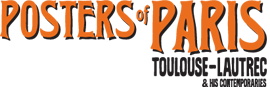Exhibition Dictionary
- Absinthe
- A distilled, anise-flavored alcoholic beverage particularly favored among artists and poets for its “psychoactive” qualities. Toulouse-Lautrec was reported to have enjoyed absinthe mixed with cognac in a cocktail called un Tremblement de Terre (an earthquake).
- Affiche Artistique
- A poster, not merely a sign, which contains elements of artistic expression.
- Affichomanie
- Poster Mania
- Bal-Musette
- A musical style incorporating the accordion that originated in the province of Auvergne, France. It was performed at small bars and dancing establishments in Paris rather than in large, high ticket-priced ballrooms.
- Belle Époque
- The golden era (the beautiful times)
- Cancan
- A dance inspired by the quadrille, the cancan features high kicks feverously performed by a chorus line of women wearing petticoats, stockings, and long skirts.
- Fin-de-siècle
- Turn of the century (end of the century)
- Les Folies-Bergère
- A music hall near a Parisian street named rue Begère, it featured operettas, comic opera, popular songs, gymnastics, and eventually jazz music in the 1920s.
- Japonisme
- A French art movement inspired by Japanese art, of which Toulouse-Lautrec was its most brilliant disciple.
- Joie de Vivre
- Translated as the “joy of living,” this phrase can also be used to describe a person with a zest for life.
- Moulin Rouge
- The famous Parisian cabaret that translates into “The Red Mill” in English. Built in 1889 in the red light district of Pigalle, it gave birth to the cancan.
- Plein Air
- A French expression meaning to paint outdoors, instead of in a studio. The style became popular after the invention of paint in tubes in the 1870s.
- Postes et Télégraphes
- At the end of the nineteenth century, the postal and telegraph services were becoming more available to the general public.
Merci à le Alliance Francaise de Milwaukee


